|
Winton
|
1897
- 1924 |
Country: |
 |
|
Opinions vary as to who can actually claim the title as founder of the American automobile industry, but one thing is certain: one of the first to sell a production car to a private individual was Alexander Winton, who was born in a little village near Glasgow in Scotland in 1860.
Winton's father was a blacksmith who specialised in the manufacture of farm implements, and young Alexander went to school within earshot of the Clydeside shipyards. He learned the rudiments of mechanics from his father, then perfected his knowledge working in those shipyards, and from there it was a logical step to a job as a ship's engineer.
The Winton Cycle Company
By 1884, however, the call of terra firma had proved too strong, and young Winton signed on with the Phoenix Iron Works, in Cleveland, Ohio. After a while, he struck out on his own, founding the Winton Cycle Company in Cleveland; among their products was a shaft-driven cycle, which gave Winton an excellent grounding in the design of bevel gear transmissions.
Sometime around 1895 he built a motor cycle, using a proprietary unit; the machine apparently ran, but its performance was so poor that Winton determined to build his own engine, and install it in a carriage. The first Winton was completed in September 1896, and was driven by a two-cylinder vertical engine with 5 inch bores and electric ignition; it had shaft drive to a live rear axle. Winton thus eliminated the tortuous progress via belts or chain drive which beguiled so many early constructors although he reverted to chains in the 1900-1904 period.
Another advanced feature gleaned from Winton's experience as a cycle manufacturer was the use of tangent-spoked wire wheels carrying pneumatic tyres. This car's first outing was a five-mile run from the Winton works to the main square in Cleveland and back carrying five passengers; it subsequently made many trips, in all kinds of weather and over all sorts of roads and on Decoration Day Winton broke the world's record with this same machine managing a mile on a circular track in 1 minute 48 seconds.
The Winton Motor Carriage Company
The prototype was so successful that Winton decided to go in for the commercial manufacture of motor vehicles, and on 30 March, 1897, the Winton Motor Carriage Company was organised, with a capital of $200,000. Sixty days after the formation of the company, their first 'new and improved carriage was turned out', and on the 12th June it was given a 60 mile road test from Cleveland to Elyria and back, carrying four passengers, taking five hours for the trip and consuming six gallons of stove gasoline. The engine was of the hydro-carbon type, compact, powerful and practically noiseless'; seven gallons of fuel were carried, 'which the patent feeder converts to a fixed gas before entering the cylinders, without any objectionable features of the carburetor now in general use'.
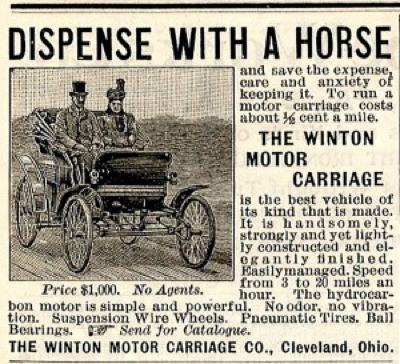 An early Winton advertisement explaing the virtues of the automobile overthe horse.
An early Winton advertisement explaing the virtues of the automobile overthe horse.
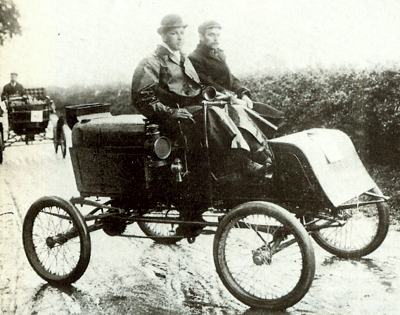 1901 Winton with chain drive.
1901 Winton with chain drive.
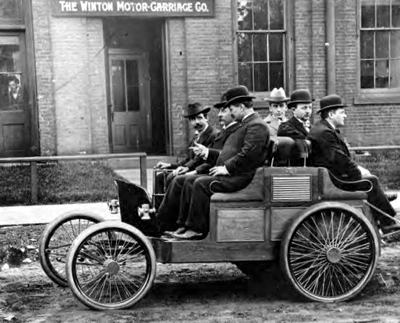 Still tiller driven, this early Winton was the forerunner to the Omnibus built, but never paid for, after they scared horses on Cleveland's Shore Drive.
Still tiller driven, this early Winton was the forerunner to the Omnibus built, but never paid for, after they scared horses on Cleveland's Shore Drive.
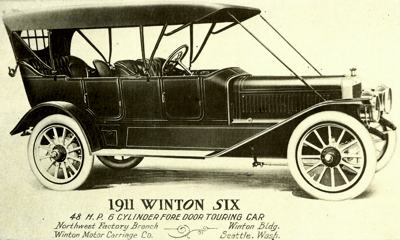 1911 Winton Six, powered by a 48hp engine.
1911 Winton Six, powered by a 48hp engine.
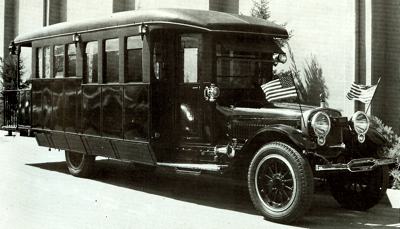 1917 Winton Custom House Car, which used the same engine as the Six.
1917 Winton Custom House Car, which used the same engine as the Six.
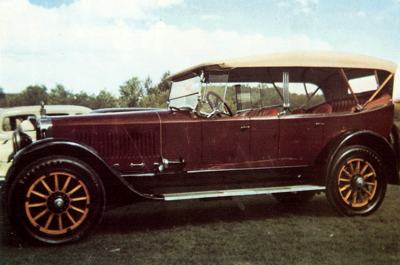 1919 Winton Model 24 seven passenger tourer.
1919 Winton Model 24 seven passenger tourer. |
Frightened Horses on Cleveland's Shore Drive
The engine and transmission were 'snugly concealed' inside the polished wood body of the Winton, and pneumatic tyres and wire wheels were standard. Already Alexander Winton was demonstrating an abiding passion for compressed air as a medium of control: 'Mr Winton's perfected and patented pneumatic governor places the machine under perfect control, and by pressing a button the speed can be increased and held anywhere from zero up to the maximum power of the motor, which is capable of thirty miles per hour.'
The maturity of the design was quite remarkable: and when the car appeared, Winton had already signed a contract with the Automobile Company of Cleveland to supply half-a-dozen motor omnibuses, which were completed and delivered - but never paid for, because they frightened horses along Cleveland's Shore Drive, inviting legal action.
James W. Packard of Warren, Ohio
Then a light, 1400lb phaeton was developed, and it was one of these which Winton sold on 24 March, 1898, claiming this as the first American sale of a petrol car - though it was later agreed that this honour belonged to Duryea, Winton's sale was the first to signal a continuing commercial production. Not that everything was easy going. One customer, at least, proved difficult: the twelfth Winton to be produced was sold to James W. Packard, of Warren, Ohio, who complained that its performance was not all that it might be. 'If you're so smart, Mr Packard, why don't you build a better car,' the short-tempered Winton is reputed to have snapped. 'I will, Mr Winton, I will,' rejoined Packard. And he did ...
Alexander Winton soon realised that the most effective way of promoting his products was to set up speed and distance records. In 1897 he had driven from Cleveland to New York, and repeated the feat in May 1899; the same year, Winton achieved international notoriety by challenging Fernand Charron, winner of the Paris-Bordeaux race, to come to America and race Winton over any distance up to 1000 miles, each driver to wager $10,000, winner take all. Charron accepted, and deposited 20,000 francs with the Paris office of the New York Herald as evidence of his good faith: but Winton didn't bother to reply.
The Gordon Bennett Trophy
It seems as though the challenge was sheer bombast. But it did have a positive result, triggering off a train of thought that led wealthy newspaper proprietor James Gordon Bennett to propose the Gordon Bennett Trophy race: and when the first Gordon Bennett was held in June 1900, Winton brought his latest racing car over to France to take part as the sole representative of America. The Winton machine, with its massive 3806 cc single-cylinder engine and tiller steering, caused much comment in the French press: but wheel and tire troubles eliminated it from the race at an early stage leaving Charron to win the event.
Beaten by Henry Ford in the Grosse Pointe 10-mile Sweepstake
Winton, however, continued to race in America, where the opposition was not so competent; in 1901 he set up a 'world's record' of 1 minute 14 seconds for a mile (48-48 mph), while in September 1900 he had won a 50 mile race at Chicago in 1 hour 17 min 50 sec (38.54mph). On 20 May, 1901, Winton attempted to drive across the United States, and managed to traverse the snows of the High Sierras, but bogged down in the sands of the Nevada desert. His many victories on the race track established him as America's leading race driver; it was, therefore a matter for some comment when he was defeated by the relatively unknown Henry Ford in the Grosse Pointe 10-mile sweepstake race in October 1901; though neither man realised it - they were friendly rivals (Winton even offered to help Ford redesign his steering gear after the race) it was a watershed in their careers.
Winton was the leading light in the American auto industry, but his production methods had advanced little from those of the Clydeside shipyards: his cars were made one at a time, by crude and laborious methods which meant that output could never be significantly increased. Ford, on the other hand, was striving towards methods of producing in larger quantities. But Winton's eclipse was far from sudden: so long as the car market remained small, he was still an important figure in the industry, and could uphold his claim that the horizontal-engined Winton was 'the best-automobile for long-distance touring manufactured or sold in America.'
Doctor H. Nelson Jackson
Doctor H. Nelson Jackson made what was claimed to be the first successful coast-to-coast crossing of the United States by motor car in 1903, a feat greeted by such disbelief from the rest of the industry that Winton put up a stake of $25,000, offering it to anyone who could prove that the chorus of malicious stories' were fact. There were no takers. That Winton was still regarded as a major force in the American motor industry was indicated by the fact that he was given the first place in the American team for the 1903 Gordon Bennett, while the other two places had to be contended for, and one was awarded to Percy Owen (Winton).
The Winton Bullets
Winton had built two racing cars for the 1903 season, wedge-shaped machines called 'Bullets', whose low profile was somewhat marred by the high exposed driving seat. He had experimented with a vertical four-cylinder engine in March 1903 when one of the Bullets so equipped covered a mile in 52.2 seconds (68.87 mph) on Ormond Beach, but for the Gordon Bennett, he reverted to his traditional horizontal cylinders. Winton's car for the event had eight cylinders and displaced 17,028 cc, while Percy Owen's 'Baby Bullet' had four cylinders of exactly half that capacity: the smaller car had a two-speed transmission, in common with the contemporary touring models, while the eight-cylinder Bullet had only one gear.
Neither car finished the race, though they subsequently appeared in track events in America, and still survive today in the Smithsonian collection, in Washington. The distinctive deep red known as Winton Red was America's first international racing livery: had Winton not dropped out of front-line racing after 1903, it is possible that Italy might have had to adopt a different racing colour. As it was, when the US re-entered motor sport in the Grand Prix era, it was allocated blue and white, as Italy had assumed red.
The Winton Quad
The year 1904 saw a flat-four with dummy bonnet added to the range: known as the Winton Quad, it cost $3200 against the $2300 of the old flat-twin Winton, which ceased production at the end of the year. For 1905, vertical four-cylinder engines were standardised throughout the range, which consisted of a 16/20 hp ($1800), a 24/30 hp ($2500), and a 40/50 hp ($3500). All had a new type of suspension, which became as characteristic of the Winton as the pneumatic governor on the inlet valves; this had two superimposed semi-elliptic springs so shackled that only half the spring was in action on smooth roads, while on bad surfaces both halves came into play.
Whys and Wherefores of the Automobile
In 1906, production was concentrated on the 30 hp Model K of 5801 cc, which was succeeded for 1907 by the broadly similar Type XIV;, there was also a 40 hp four-speed Model M that year, in which Winton issued a 'soft-sell' book called Whys and Wherefores of the Automobile, a how-it-works guide for the novice which, prepared by the 'Automobile Institute, Cleveland,' extolled all the design virtues of the Winton without actually naming names. The customer had to guess that he was meant to buy a Winton....
The changing tempo of the car market meant that the Winton, which had originally been a medium-priced gas buggy, was now moving towards the luxury price range without any real change in design attitudes, and new models such as the 7817 cc Six-Teen-Six of 1908 represented an even more pronounced swing away from reality. The Winton was becoming a kind of automotive coelacanth, a living fossil beyond its era. Alexander Winton's craze for compressed air took a new turn in 1909 when a 9505 cc six was offered with a pneumatic starter, which within two years also incorporated a tire pump.
Gradually becoming more conventional (electric lighting and starting appeared in 1915), Winton cars were built until 1924, when the company wisely decided to channel their energies into the production of marine diesel engines instead; and it was in this field that they were to survive, latterly as a component of General Motors, into the 1970s.
